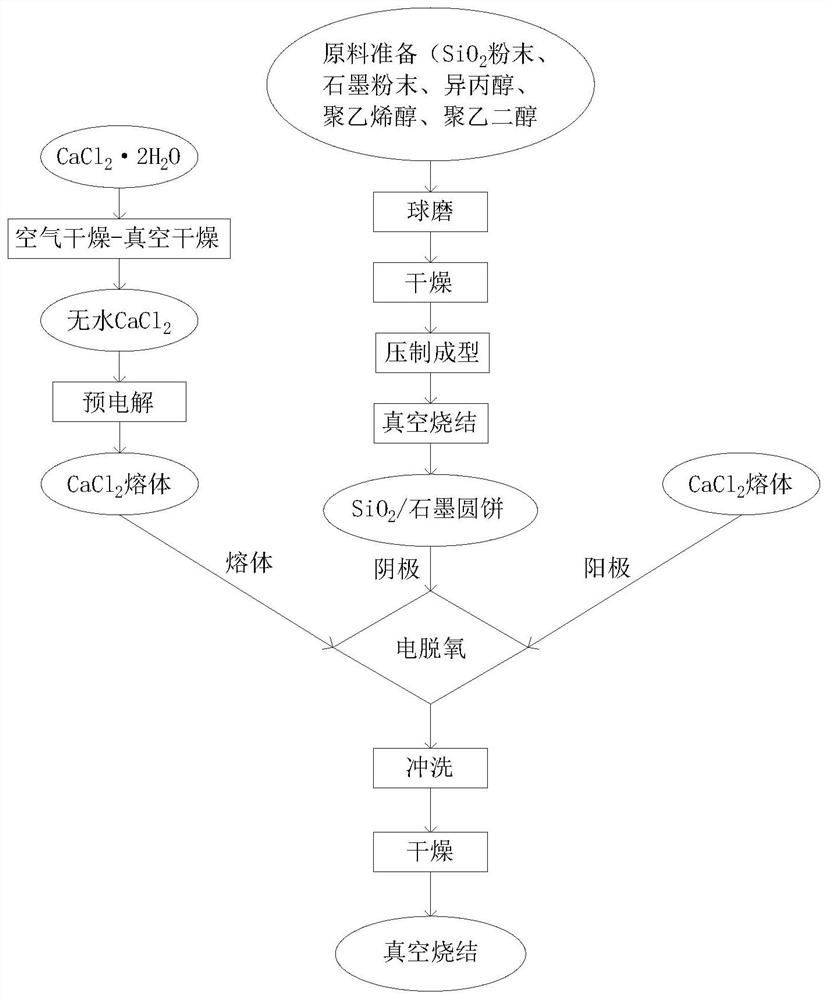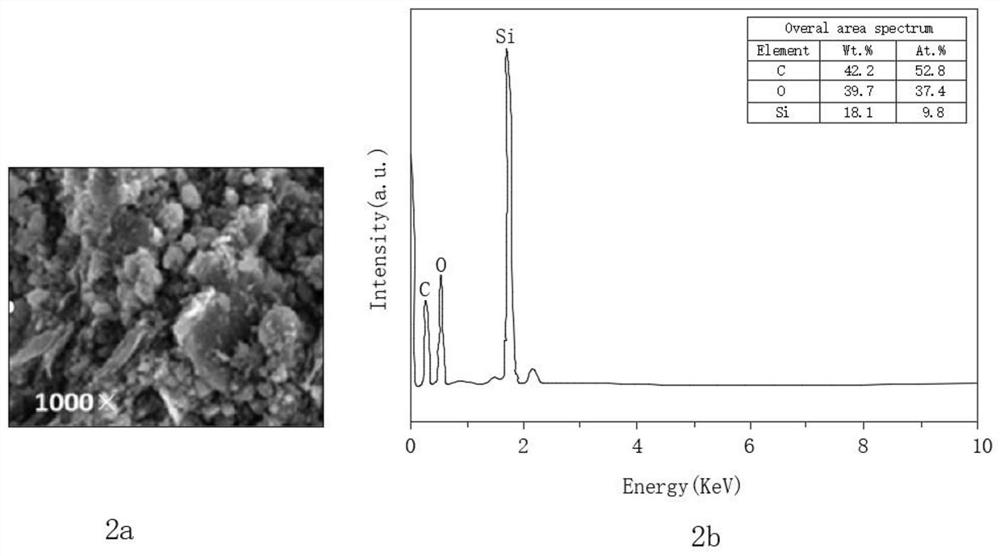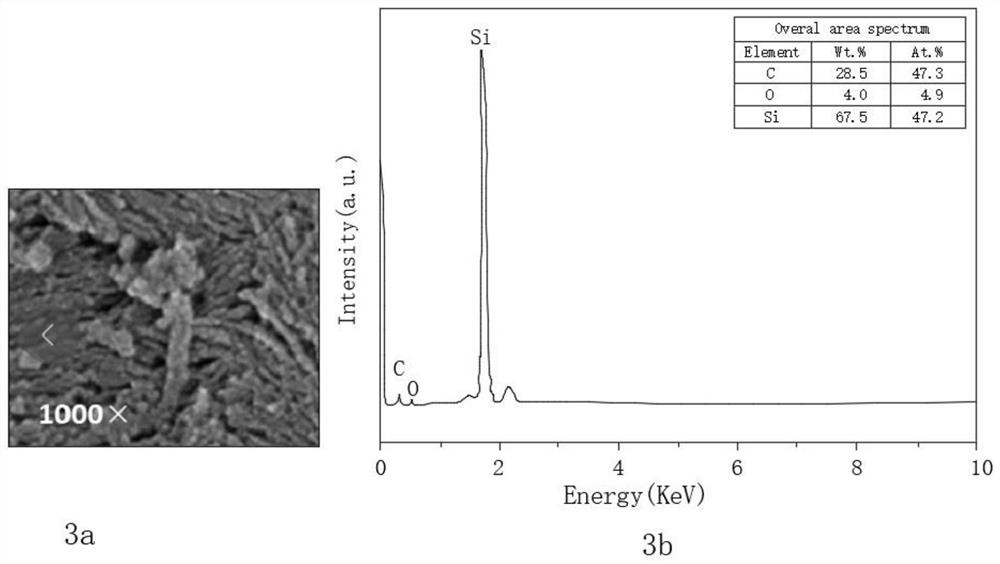Preparation method of nanometer SiC capable of being used as negative electrode material of lithium ion battery
A lithium-ion battery and negative electrode material technology, applied in the field of lithium-ion batteries, can solve problems such as complex synthesis routes, coarse particles, and lack of purity, and achieve the effects of simple process, low energy consumption, and low cost
- Summary
- Abstract
- Description
- Claims
- Application Information
AI Technical Summary
Problems solved by technology
Method used
Image
Examples
Embodiment 1
[0045] First weigh 98 parts of isopropanol, 1 part of polyvinyl alcohol, and 0.5 parts of polyethylene glycol, put them into a ball mill tank, stir properly with a glass rod, and then weigh 10 parts of SiO 2 The powder and 15 parts of graphite powder should be properly stirred with a glass rod and then ball milled. After being fully dispersed, take it out and dry it in a drying oven at 100°C. Press it into a 0.4g round cake with a diameter of 12mm under a pressure of 5MPa. , transferred to a high-temperature oven for sintering at 1200°C, the sintering time is 2.5h, and the sintering atmosphere is Ar+3vt%H 2 , in addition, take 550g CaCl 2 2H 2 O was dried in air at 180°C for 48h and then vacuum-dried at the same temperature for 24h, or air-dried at 260°C for 12h and then vacuum-dried at the same temperature for 6h to obtain CaCl 2 , weigh the CaCl prepared in the previous step 2 About 400g is placed in an alumina crucible, and then placed in a vertical high-temperature rea...
Embodiment 2
[0048] First weigh 99 parts of isopropanol, 1.2 parts of polyvinyl alcohol, and 1 part of polyethylene glycol, put them into a ball mill tank, stir properly with a glass rod, and then weigh 5 parts of SiO 2 The powder and 8 parts of graphite powder were properly stirred with a glass rod and started ball milling. After being fully dispersed, they were taken out and dried in an oven at 110°C. Under a pressure of 8MPa, they were pressed into a 1g round cake with a diameter of 18mm. Transfer to a high temperature oven for sintering at 1250°C, the sintering time is 3h, and the sintering atmosphere is Ar+4vt%H 2 , In addition, take 550g CaCl 2 2H 2 O was dried in air at 180°C for 48h and then vacuum-dried at the same temperature for 24h, or air-dried at 280°C for 12h and then vacuum-dried at the same temperature for 6h to obtain CaCl 2 , weigh the CaCl prepared in the previous step 2 About 400g is placed in an alumina crucible, and then placed in a vertical high-temperature react...
Embodiment 3
[0051] First weigh 100 parts of isopropanol, 1.5 parts of polyvinyl alcohol, and 1 part of polyethylene glycol, put them into a ball mill tank, stir properly with a glass rod, and then weigh 10 parts of SiO 2 The powder and 15 parts of graphite powder are properly stirred with a glass rod and started ball milling. After being fully dispersed, take them out and put them in an oven for drying at 120°C. Press them into a 2g round cake with a diameter of 25mm under a pressure of 10MPa. Transfer to a high-temperature oven for sintering at 1300°C, the sintering time is 2.5h-3.5h, and the sintering atmosphere is Ar+6vt%H 2 , in addition, take 550g CaCl 2 2H2O was dried in air at 200°C for 48h and then vacuum-dried at the same temperature for 24h, or air-dried at 300°C for 12h and then vacuum-dried at the same temperature for 6h to obtain CaCl 2 , weigh the CaCl prepared in the previous step 2 About 400g is placed in an alumina crucible, and then placed in a vertical high-temperatu...
PUM
 Login to View More
Login to View More Abstract
Description
Claims
Application Information
 Login to View More
Login to View More - R&D
- Intellectual Property
- Life Sciences
- Materials
- Tech Scout
- Unparalleled Data Quality
- Higher Quality Content
- 60% Fewer Hallucinations
Browse by: Latest US Patents, China's latest patents, Technical Efficacy Thesaurus, Application Domain, Technology Topic, Popular Technical Reports.
© 2025 PatSnap. All rights reserved.Legal|Privacy policy|Modern Slavery Act Transparency Statement|Sitemap|About US| Contact US: help@patsnap.com



